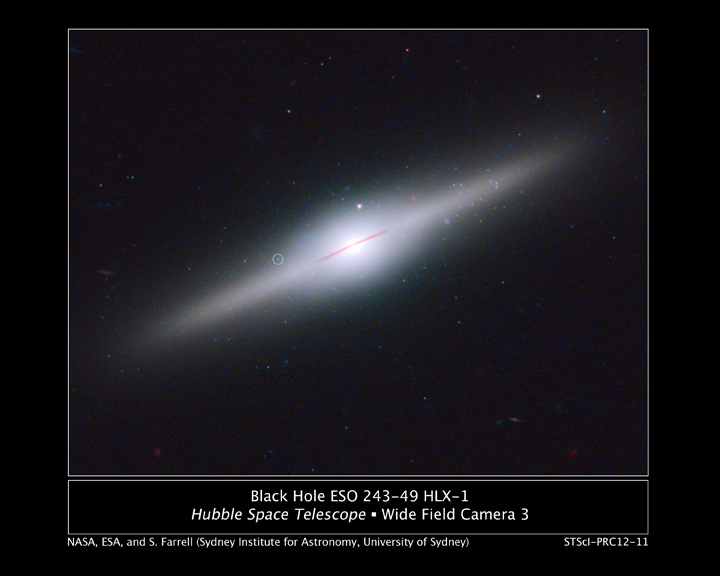Rare Black Hole Survives Galaxy's Destruction

Like a fossil hinting at a long-gone animal, a black hole is offering clues about a now-destroyed galaxy that may once have existed around it.
The Hubble Space Telescope recently spied a cluster of young blue stars surrounding a rare mid-weight black hole that suggests the black hole was once at the center of a dwarf galaxy. Astronomers think this galaxy was torn apart by the gravity of a larger host galaxy that it orbited.
The violent encounter would have stripped away most of the dwarf galaxy's stars, but it also could have compressed the gas around its central black hole, triggering a new wave of star formation. It is these new stars that Hubble recently saw signs of.
The observations suggest that the young stars must be less than 200 million years old, meaning the collision between the parent galaxy and its dwarf likely occurred around that time.
"The fact that there's a very young cluster of stars indicates that the intermediate-mass black hole may have originated as the central black hole in a very low-mass dwarf galaxy,"Sean Farrell, of the Sydney Institute for Astronomy in Australia, said in a statement. "The dwarf galaxy was then swallowed by the more massive galaxy." [When Galaxies Collide: Photos of Great Galactic Crashes]
Besides revealing clues about the lost galaxy, the black hole itself, called HLX-1 (Hyper-Luminous X-ray source 1), is scientifically interesting, researchers said.
When Farrell and his colleagues discovered HLX-1in 2009, it was the first intermediate-mass black hole known. Scientists think it may represent a class of middleweight black holes that are the building blocks for the supermassive black holes lurking at the center of most large galaxies, including our own Milky Way.
Get the Space.com Newsletter
Breaking space news, the latest updates on rocket launches, skywatching events and more!
"This black hole is unique in that it's the only intermediate-mass black hole we've found so far. Its rarity suggests that these black holes are only visible for a short time," said Mathieu Servillat, a member of the research team who conducted his work at the Harvard-Smithsonian Center for Astrophysics in Cambridge, Mass.
This specimen contains the mass of about 20,000 suns, and is located roughly 290 million light-years from Earth. In comparison, the supermassive black hole at the center of the Milky Way is as massive as 4 million suns.
By studying this rare middleweight black hole, scientists hope to learn more about how they, and their larger supermassive brethren, form.
"For the first time, we have evidence on the environment, and thus the origin, of this middle-weight black hole," Servillat said.
The researchers report their findings in the Feb. 15 issue of the Astrophysical Journal Letters.
You can follow SPACE.com assistant managing editor Clara Moskowitz on Twitter @ClaraMoskowitz. Follow SPACE.com for the latest in space science and exploration news on Twitter @Spacedotcomand on Facebook.
Join our Space Forums to keep talking space on the latest missions, night sky and more! And if you have a news tip, correction or comment, let us know at: community@space.com.

Clara Moskowitz is a science and space writer who joined the Space.com team in 2008 and served as Assistant Managing Editor from 2011 to 2013. Clara has a bachelor's degree in astronomy and physics from Wesleyan University, and a graduate certificate in science writing from the University of California, Santa Cruz. She covers everything from astronomy to human spaceflight and once aced a NASTAR suborbital spaceflight training program for space missions. Clara is currently Associate Editor of Scientific American. To see her latest project is, follow Clara on Twitter.









